What are the hottest peppers in the world? Here is the most current hottest peppers list from hottest to mildest with Scoville Heat Units and info, updated for February 2025.
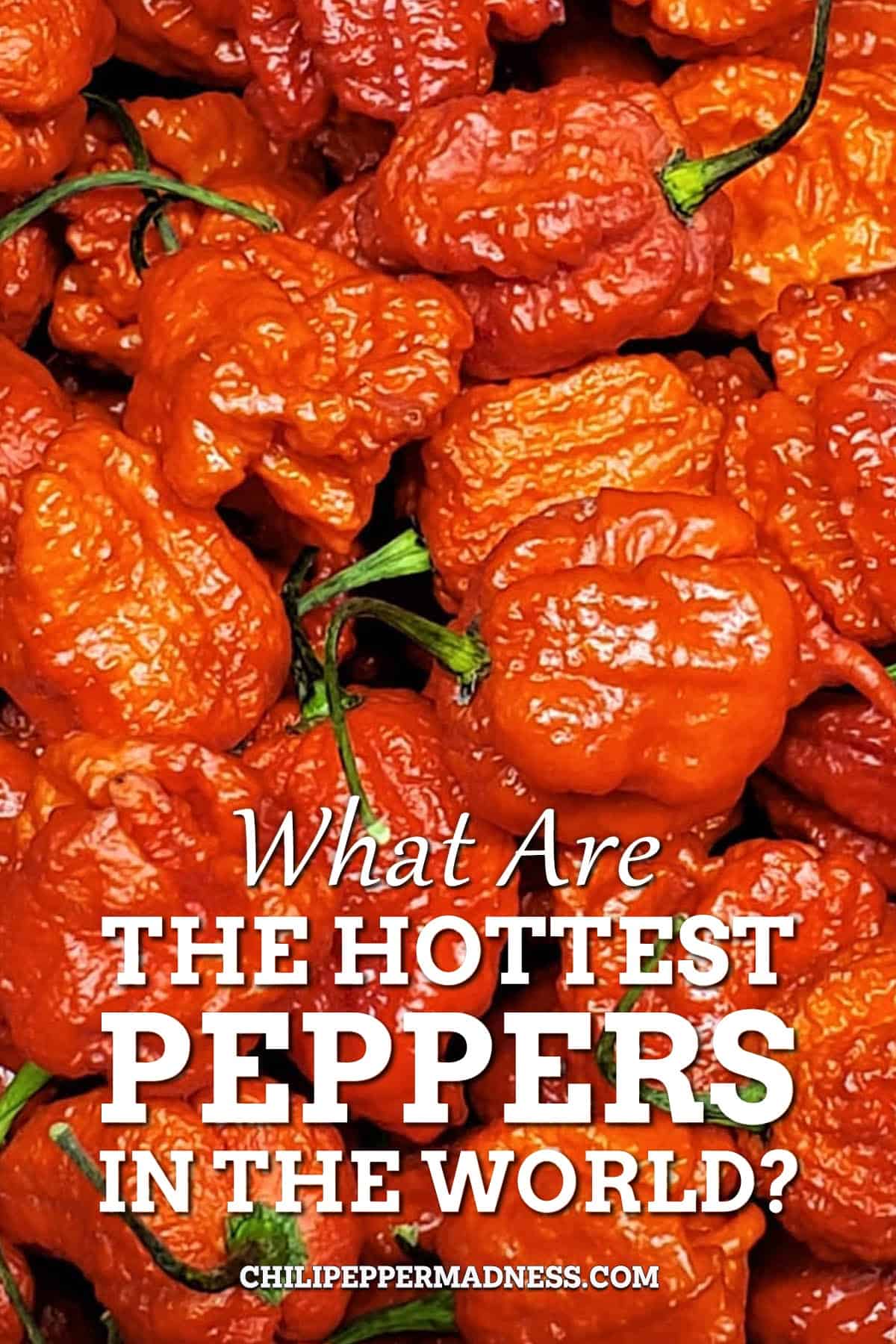
The Hottest Peppers List News & Info
The list of the hottest peppers in the world is growing all the time. Growers are producing hotter and hotter hybrids with hopes of pushing the Scoville Heat Scale limits, and there is even a reality show in the works where chili growers compete to grow the hottest peppers they can grow.
The previous official hottest pepper in the world was the Carolina Reaper, but as growers produce new and hotter superhots, a common question is - Is there a hotter pepper than the Carolina Reaper?
2017 saw a flurry of news articles with potential new "hottest pepper in the world" claims, including the "Dragon's Breath Pepper" and the ultra blazing "Pepper X", which is hotter than the Carolina Reaper. However, there have been no official confirmation of tests performed on these peppers.
The "Dragon's Breath Pepper" quite possibly may have been a publicity stunt, so there is little hope for that particular pepper, though "Pepper X" has gained the new crown of Hottest Pepper in the World as of October 2023. It was propagated by Smokin’ Ed Currie of PuckerButt Pepper Company, the man behind the current record holder, the "Carolina Reaper".
In 2022, another superhot chili pepper appeared on the scene, also developed by Ed Currie, this one called the Apollo Pepper, a cross between Pepper X and the Carolina Reaper, used to make The Last Dab: Apollo hot sauce. It is said to reach 3,000,000 SHU, also hotter than the Carolina Reaper, though official tests remain to be seen.
List Notes
Please note that while this is a list of officially tested peppers, you will still find a large range of heat from pepper to pepper, so you might personally experience a 7 Pot Primo as hotter than a Carolina Reaper. Still, all of these peppers are quite hot!
I've also included unconfirmed (non lab tested and reported) peppers in this list, but will update as new information is learned.
List of Hottest Chili Peppers in the World
Here is a list of the world's hottest peppers to date, from hottest to mildest (if you can call that mild!).
Pepper X - 3,180,000 Scoville Heat Units (SHU) - Official Hottest Pepper in the World
"Pepper X" is the temporary name for the chili pepper bred by Ed Currie of Puckerbutt Pepper Company, the same man behind the creation of the Carolina Reaper. According to Ed, he crossed multiple peppers to achieve a pepper hotter than the Carolina Reaper, the previous hottest, which measures over 2 Million Scoville Heat Units with a top range of 3.18 Million SHU. This is amazingly hot and used to make The Classic Hot Sauce: Pepper X Edition, by Heatonist.
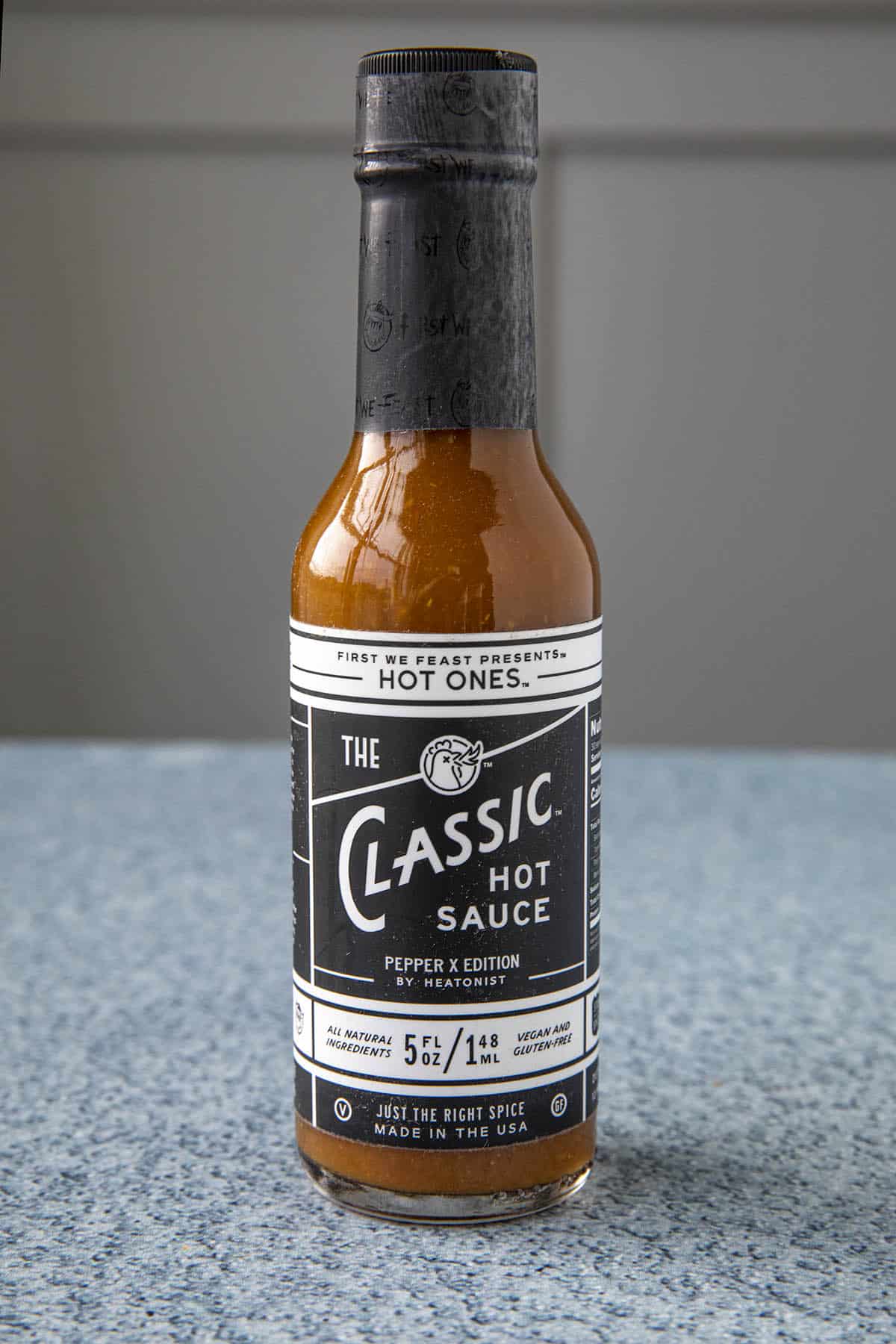
Buy The Classic Hot Sauce: Pepper X Edition from the Heatonist (Amazon Affiliate Link, my friends!)
Apollo Pepper - 3,000,000+ Scoville Heat Units (SHU) - Unofficial
Another superhot chili pepper developed by Ed Currie, developed from a cross between Pepper X and the Carolina Reaper, used to make The Last Dab: Apollo hot sauce, by Heatonist.
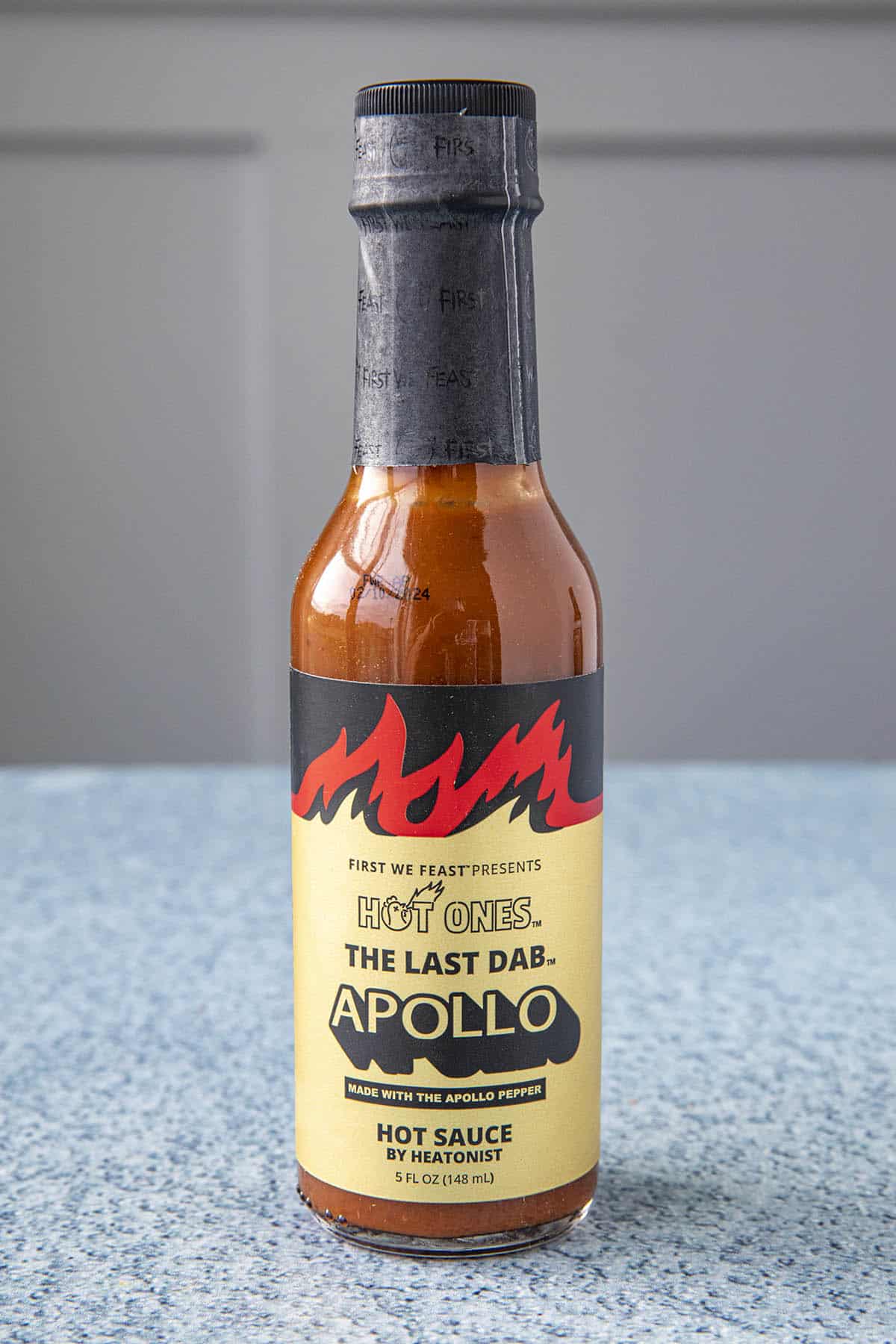
Buy The Last Dab: Apollo Hot Sauce from the Heatonist (Amazon Affiliate Link, my friends!)
Dragon's Breath Pepper - 2,480,000+ Scoville Heat Units (SHU) - Unofficial
The Dragon's Breath chili pepper is claimed to be one of the hottest chili peppers in the world with a reported 2.48 million Scoville heat units. The chili pepper originated in the United Kingdom, developed collaboratively by chili farmer Neal Price, Nottingham Trent University and NPK Technology. It looks to be a variant of the 7 Pot Infinity pepper.
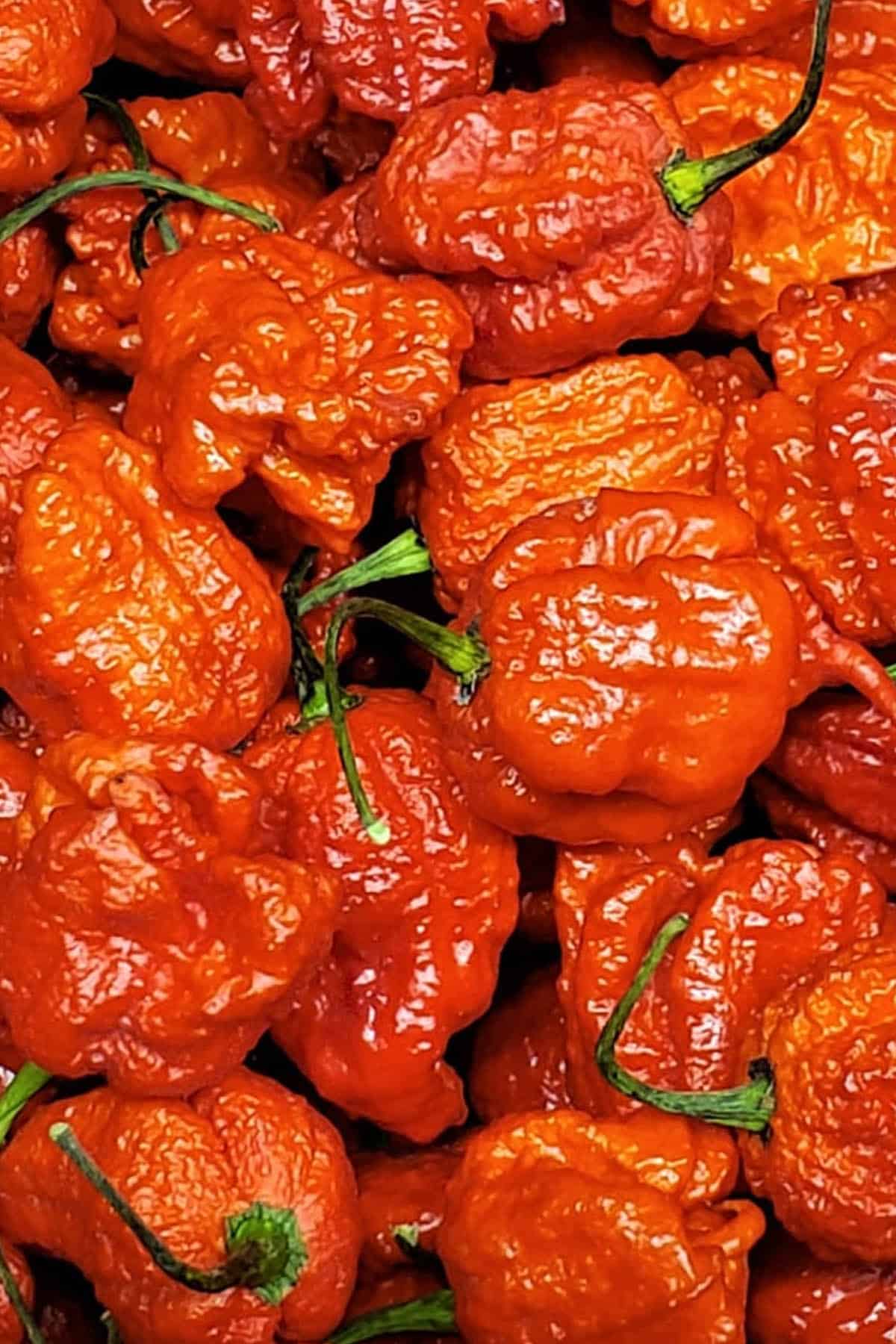
Carolina Reaper - Former Hottest Pepper in the World. 2,200,000 Scoville Heat Units (SHU)
With a Guinness-submitted 1,569,383 Scoville Heat Units average and recently measured peak levels of over 2,200,000 SHU, SMOKIN’ ED’S CAROLINA REAPER® has officially completed its long journey to the top of “super-hot” chili charts.
This is an extremely hot variety developed by a grower named Ed Currie. It is also called HP22B pepper. As of 2013 it is over 7 generations old. Ed created this chili pepper plant variety by crossing a Pakistani Naga with a Red Habanero type from St Vincents Island in the West Indies.
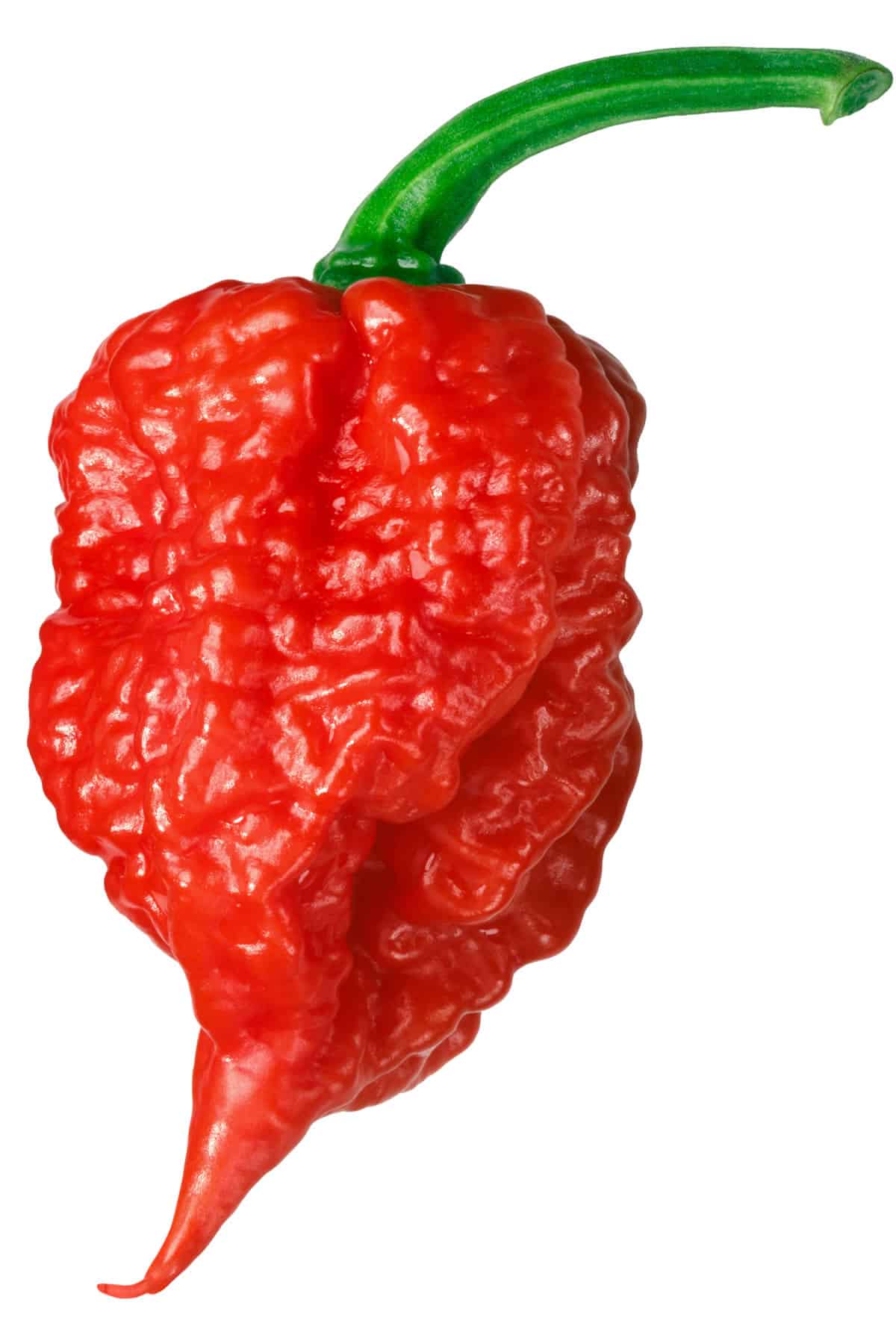
Trinidad Moruga Scorpion - 2,009,231 Scoville Heat Units (SHU).
In February 2012, the 2012 New Mexico Chile Conference, in association with Jim Duffy of Refining Fire Chiles, announced that the Trinidad Moruga Scorpion is the hottest chili pepper in the world. Clocking in at 2,009,231 Scoville Units, this chili pepper is beyond blistering. It was overtaken the next year by the Carolina Reaper.
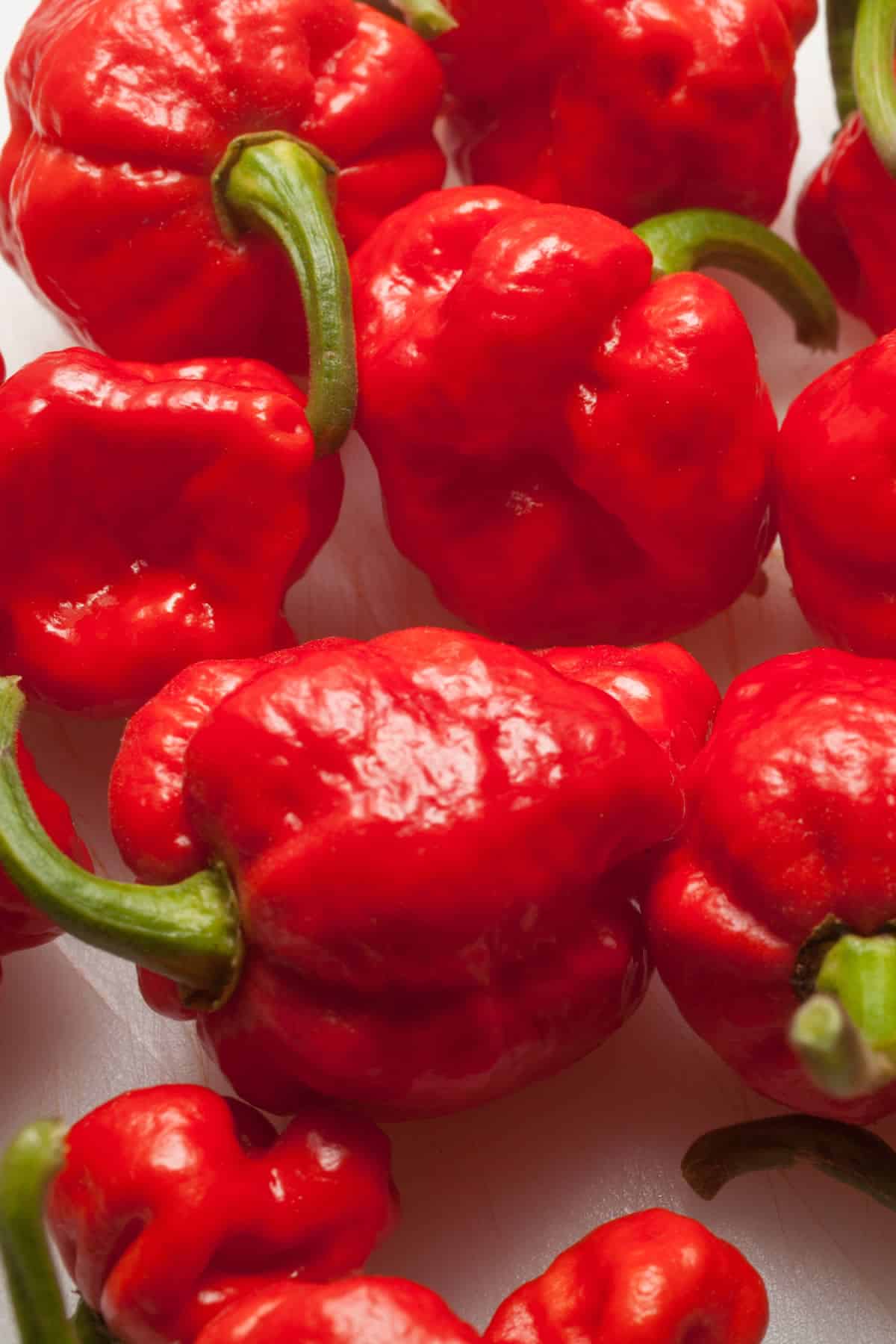
Chocolate Bhutlah - Up to 2 Million Scoville Heat Units (SHU).
Do not let the name fool you – the Chocolate Bhutlah is nothing close to being a dessert dream. It is, in fact, one of the hottest peppers on the planet, named for it's chocolate color.
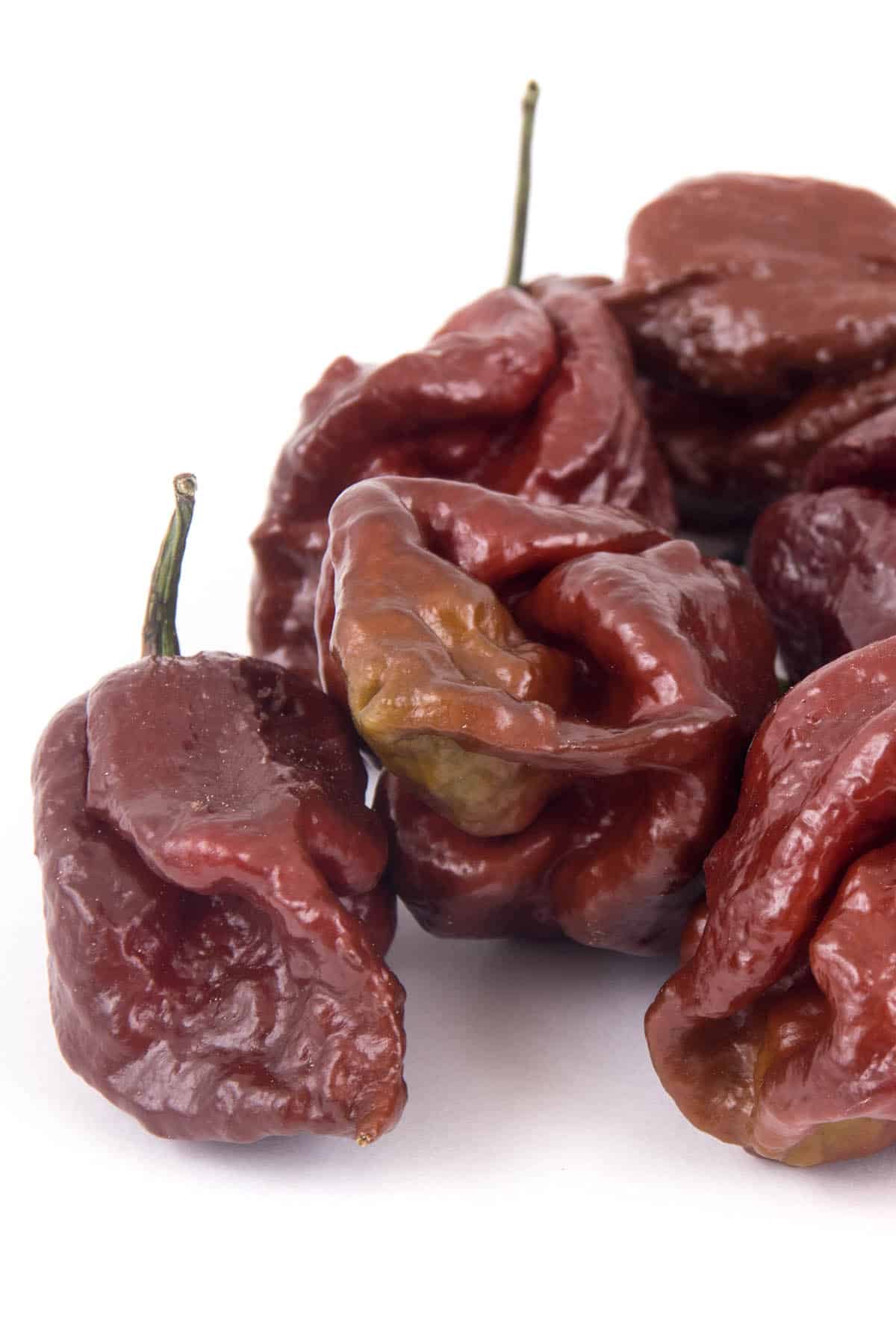
7 Pot Douglah - 1,853,936 Scoville Heat Units (SHU).
The 7 Pot Douglah is an extremely hot pepper from Trinidad. It’s skin is notably dark chocolate brown and somewhat pimpled. It starts off green but matures to a rich brown. Aside from the color, it looks very much like other superhot chili peppers, roughly habanero shaped, about two inches long.
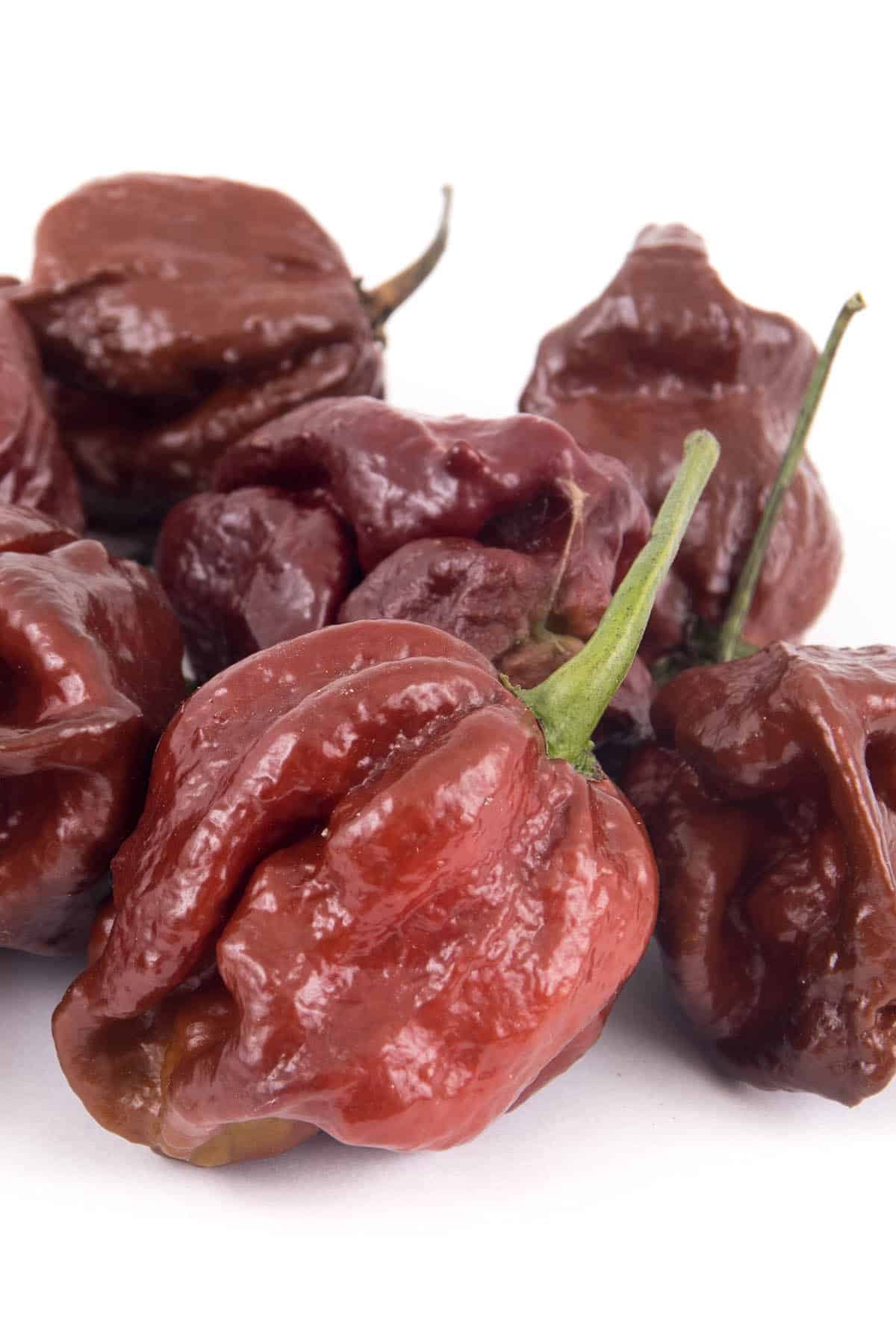
Chocolate 7 Pot Chili Pepper - 923,000 - 1.85 Million Scoville Heat Units (SHU)
From Trinidad, an island just northeast of Venezuela, the 7-Pot is a Caribbean chili. The Chocolate 7 Pot is similar in shape to the Habanero and has similar “pimpling” to other super hot peppers, like the Naga Morich. Its flavor is fruity, sweet and nutty, if you can get past the intense and sweat-inducing heat.

Dorset Naga Chili Pepper - 1 million - 1.5 million Scoville Heat Units (SHU).
Development of the Dorset Naga began near Dorset, England, around 2001 when Joy and Michael Michaud of “Peppers by Post” bought a Naga Morich plant from an Oriental foods store in southern England. The Naga Morich chile is from Bangladesh and is highly regarded in that community. Over several years they selected fruit with the specific characteristics they were looking for, and extracted seeds.
They planted those seeds and continued until they were satisfied with the result. The heat level has been tested repeatedly since 2005 and has ranged from 661,451 SHU for green fruit up to 1,032,310 SHU for ripe fruit in 2009. Another test has measured the heat level as high as 1,598,227 SHU, making it one of the hottest peppers in the world.
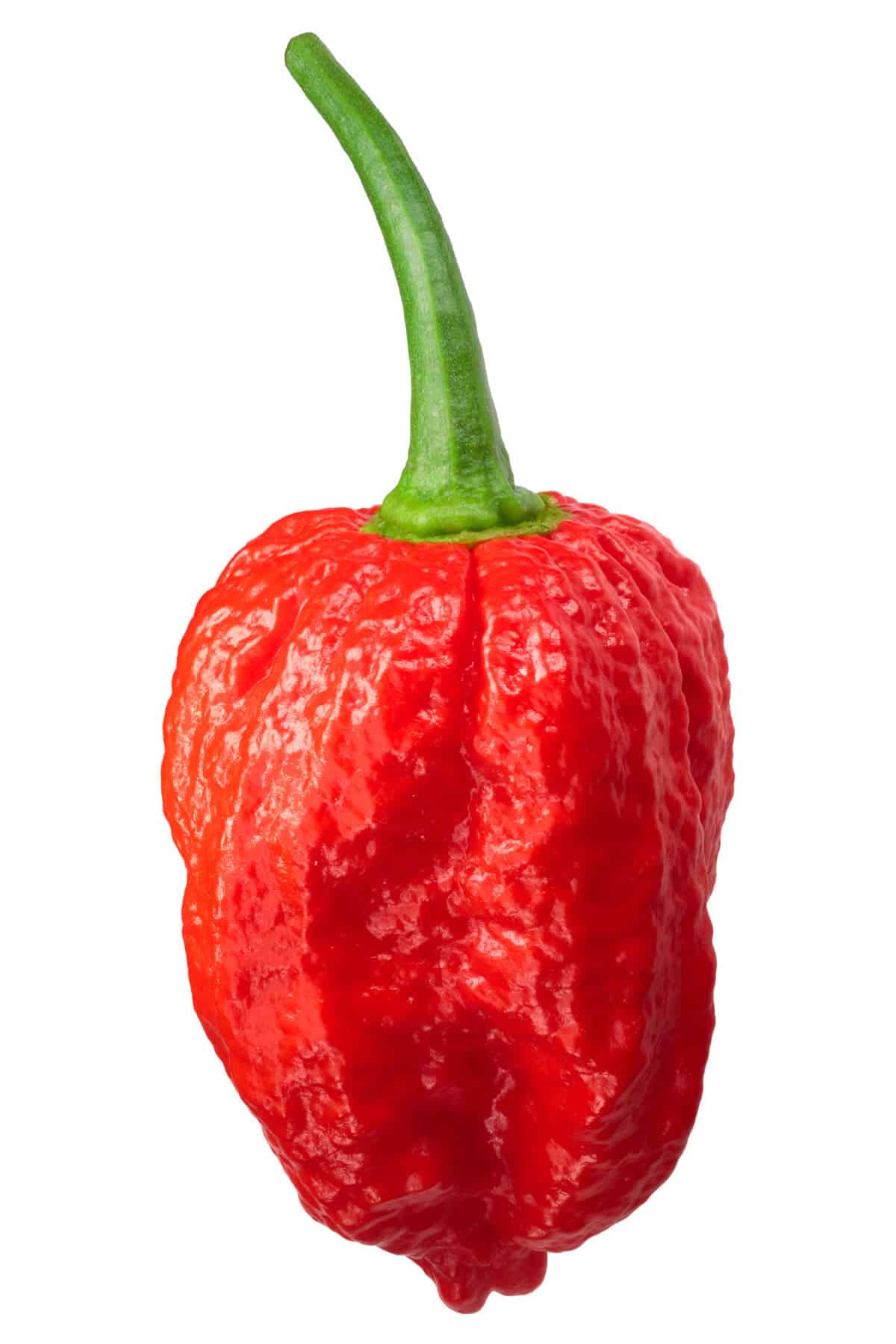
Naga Morich - 1 million - 1.5 million Scoville Heat Units (SHU).
The Naga Morich is a superhot pepper from Northeast India and Bangladesh. It is closely related to the bhut jolokia, or ghost pepper, and reaches up to 1.5 million Scoville Heat Units.
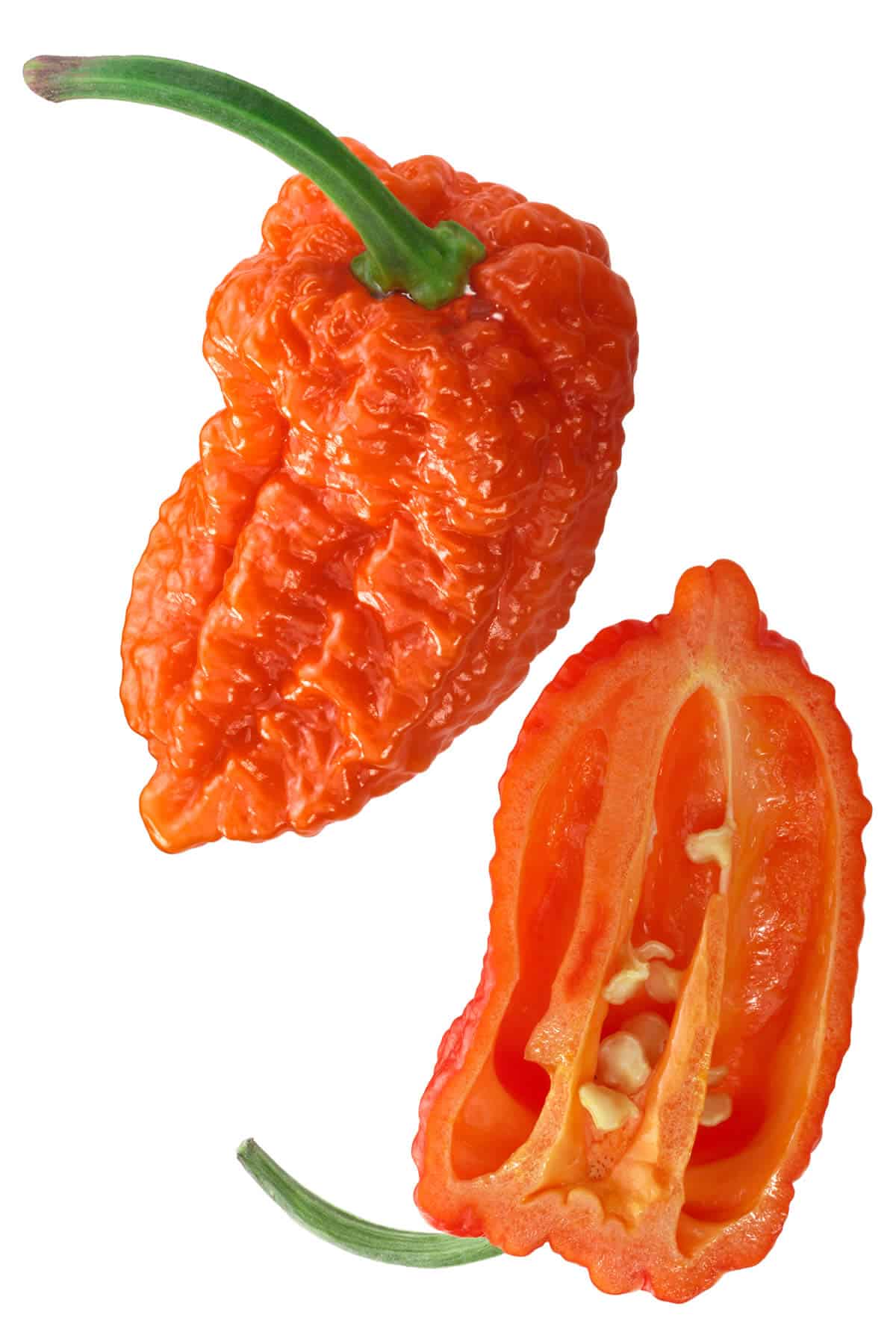
Learn more about the Naga Morich.
7 Pot Primo - 1,473,480 Scoville Heat Units (SHU).
The 7 Pot Primo is a cross between a Naga Morich and a Trinidad 7 Pot pepper. It was created by Troy Primeaux, (nickname Primo), a horticulturist from Louisiana. He began crossing the Naga Morich and Trinidad 7 Pot seeds around 2005. It has a scorpion-like tail.
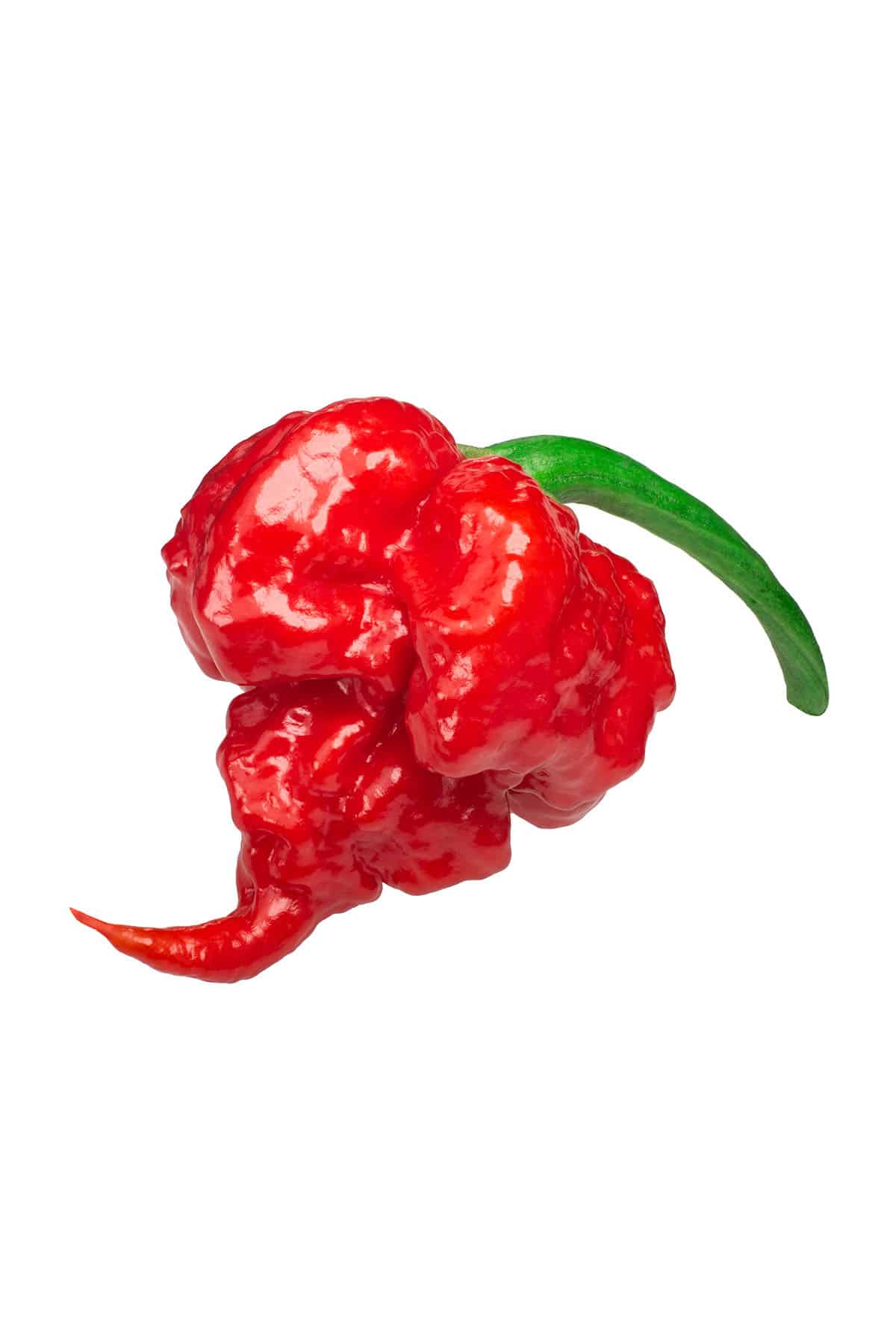
Trinidad Scorpion Butch T Chili Pepper - 1,463,700 Scoville Heat Units (SHU).
The Trinidad Scorpion Butch T has been rated at 1,463,700 Scoville Heat Units (SHU), according to recent tests. It was propagated by Butch Taylor of Zydeco Hot Sauce and grown by the Chilli Factory.
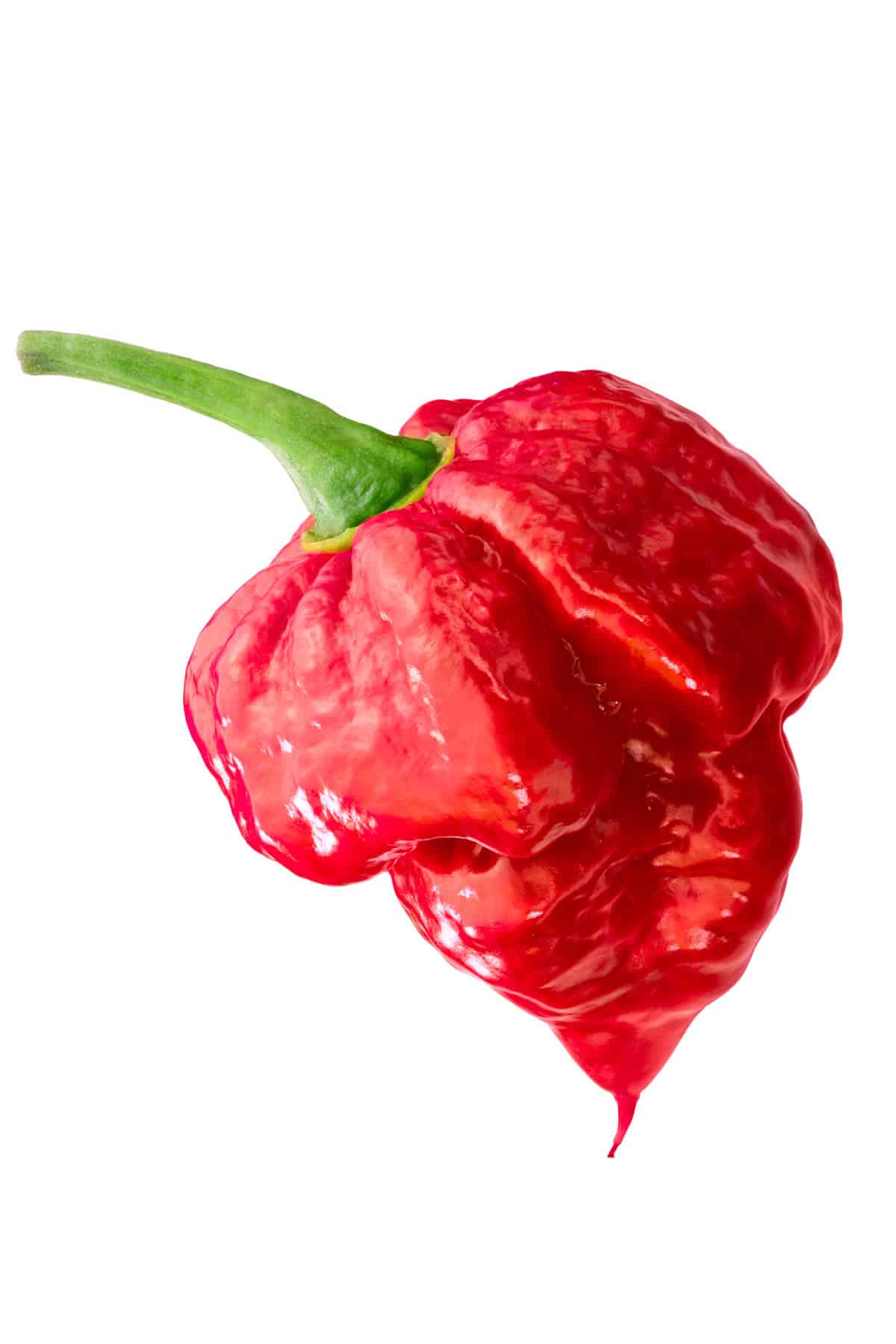
Komodo Dragon - 1,400,000 Scoville Heat Units (SHU)
Grown by the UK’s largest producer of peppers, Salvatore Genovese, who has a seven-acre farm in Blunham, Bedfordshire. He seems to have made it his goal to produce hotter and hotter chilies, which includes the Komodo Dragon. Looking forward to his future work.
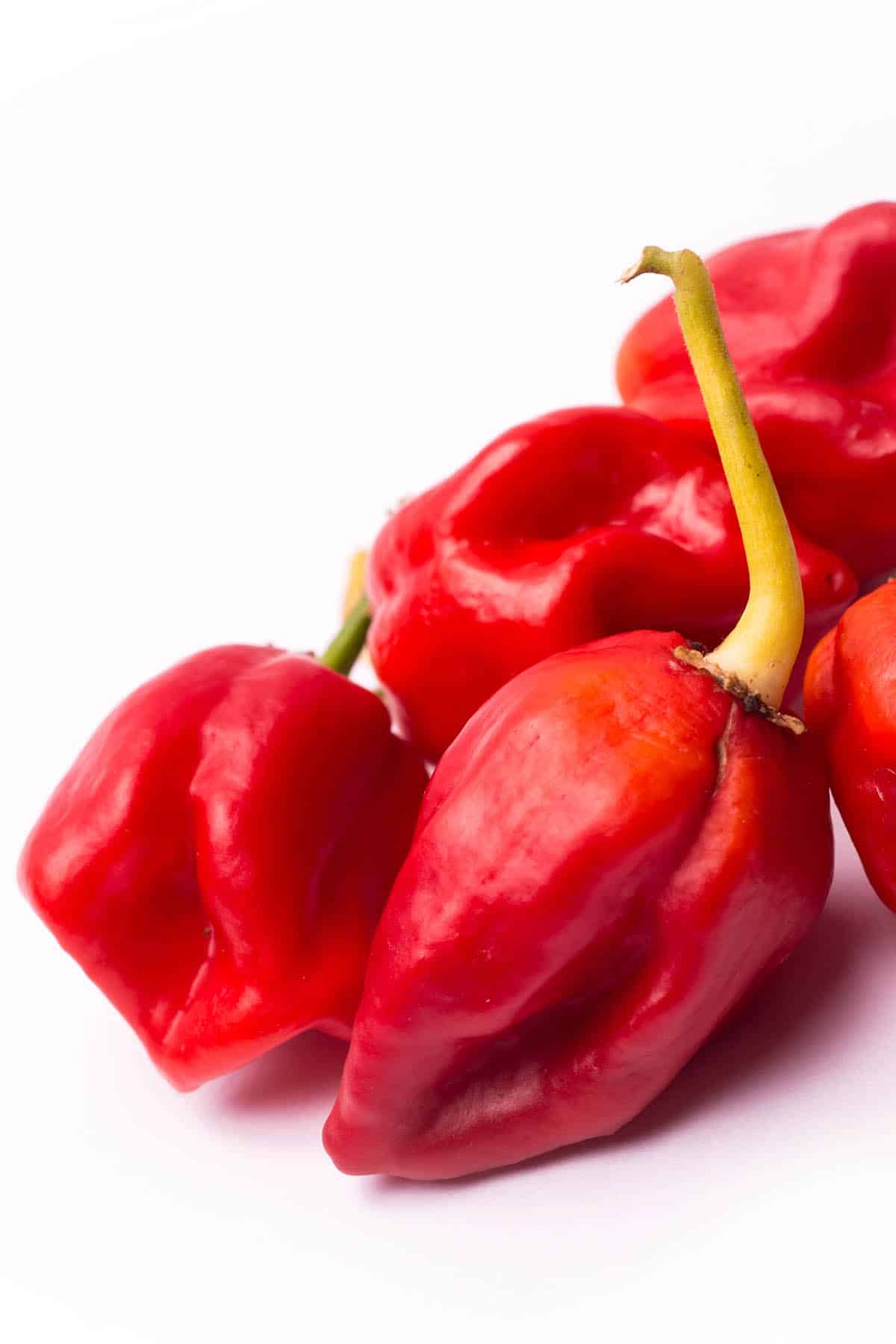
Naga Viper - 1,382,118 Scoville Heat Units (SHU).
The Naga Viper has been rated at 1,382,118 Scoville Heat Units (SHU), according to tests conducted by the Warwick HRI Mineral Analysis Laboratory, UK, in November 2010. The Naga Viper chili pepper is a hybrid of three different chili peppers - the Bhut Jolokia, the Naga Morich, and the Trinidad Scorpion.
It was created by Gerald Fowler, who runs the Chili Pepper Company in Cumbria, England. This pepper is hotter than the Naga Jolokia (or Bhut Jolokia) by a scorching 300,000 Scovilles, and is claimed to be able to peel paint. In comparison, pure capsaicin is rated at between 15,000,000 - 16,000,000 Scoville units, and police grade pepper spray is rated at about 5,000,000 Scovilles.
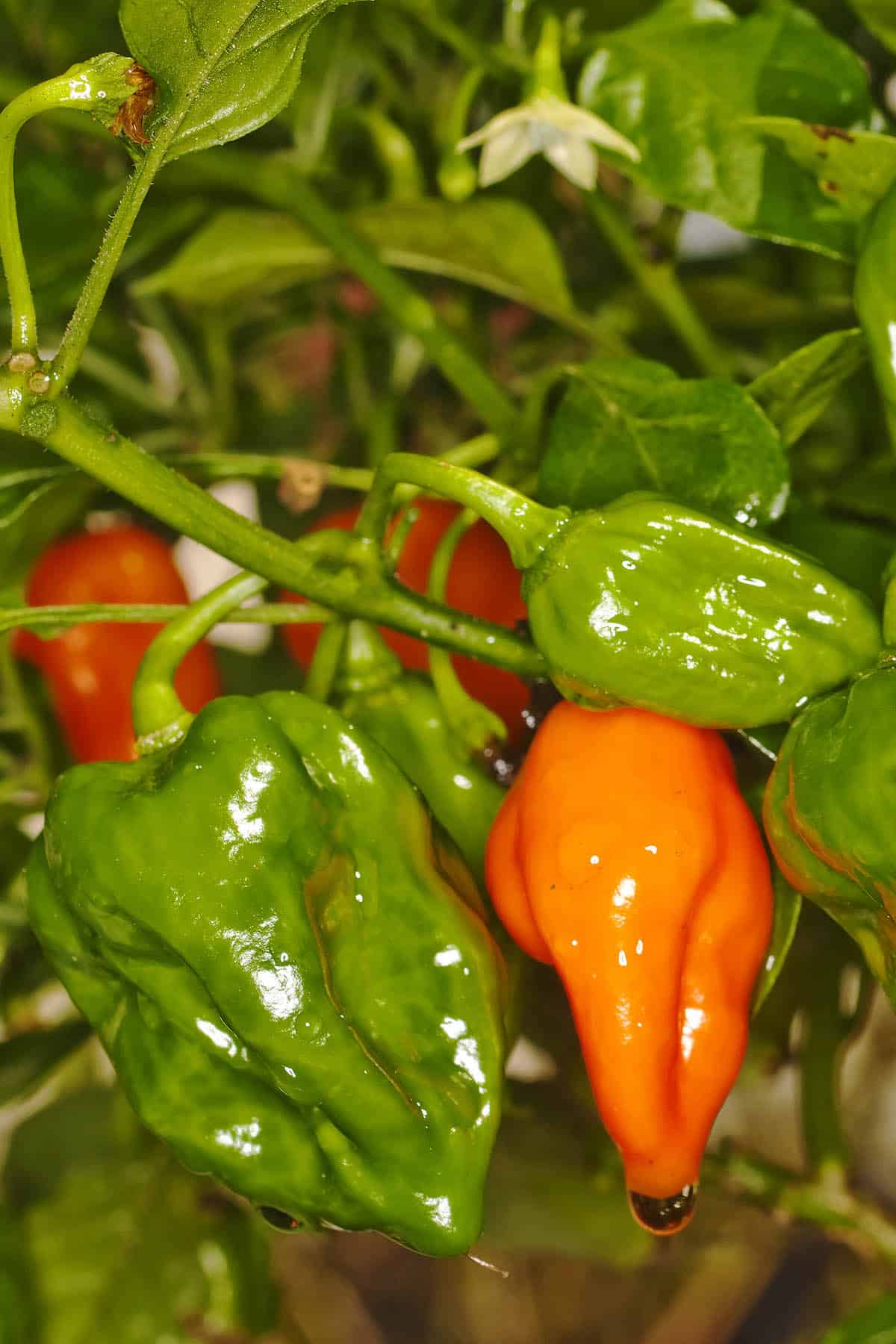
7 Pot Brain Strain - 1,350,000 Scoville Heat Units (SHU).
The 7 Pot Brain Strain was created using selective breeding by grower David Capiello, who cultivated only those peppers with specific traits, eventually producing peppers that resembled tiny pocked brains. In terms of heat, they will truly strain your brain.
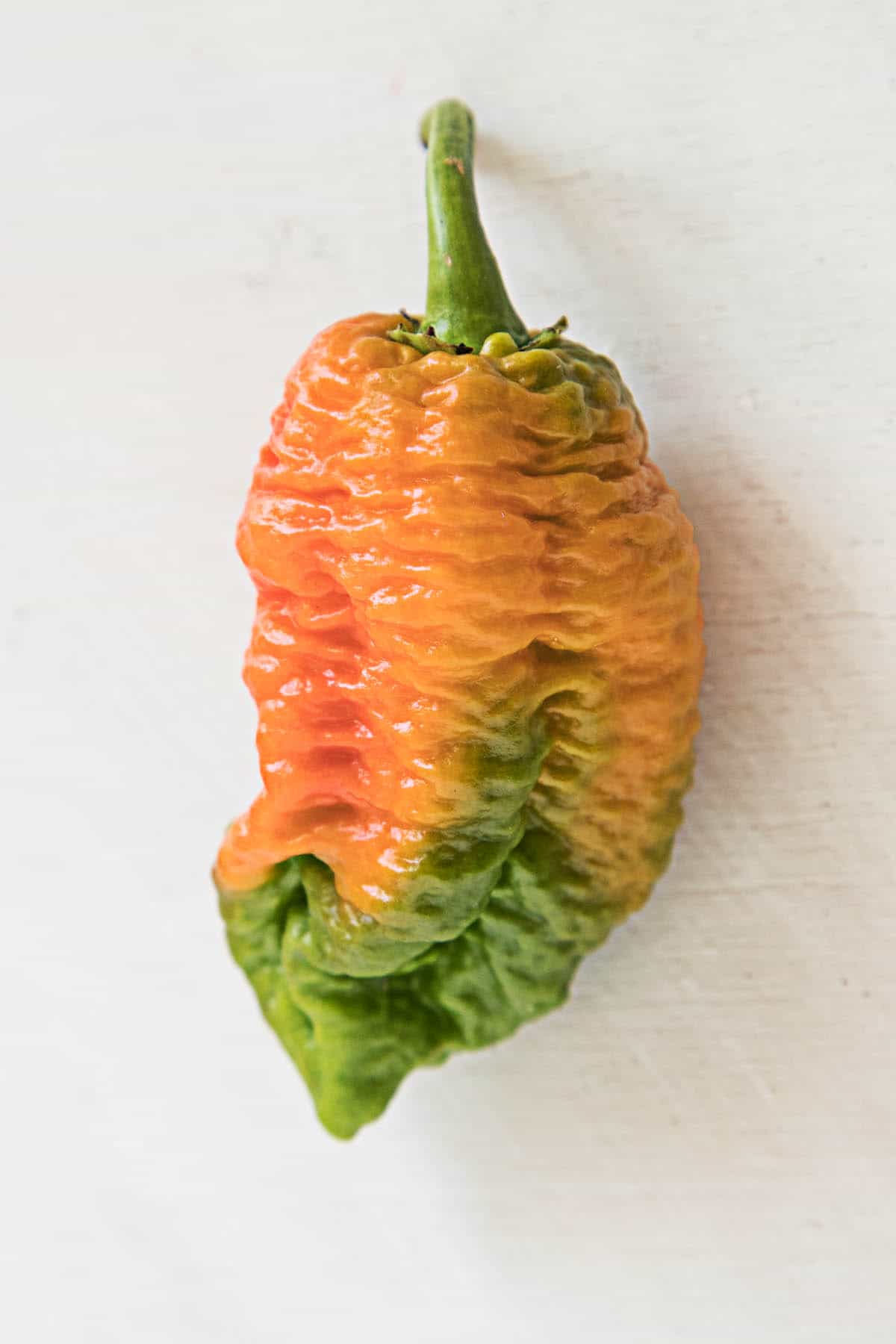
7 Pot Barrackapore - 1,300,000 Scoville Heat Units (SHU).
From the region of Barrackpore on the Caribbean Island of Trinidad. The Trinidad 7 Pot Barrackpore produces larger pods that most 7 pot varieties, with more wrinkles and longer pods. If you can get passed the heat, you'll enjoy a fruity flavor.
Infinity Chili - 1,067,286 - 1,250.000 Scoville Heat Units (SHU).
Created in England by Nick Woods of “Fire Foods,” the Infinity Chili Pepper held the World Record for the world’s hottest chili pepper for two weeks in 2011, before it was ousted by the Naga Viper chili.
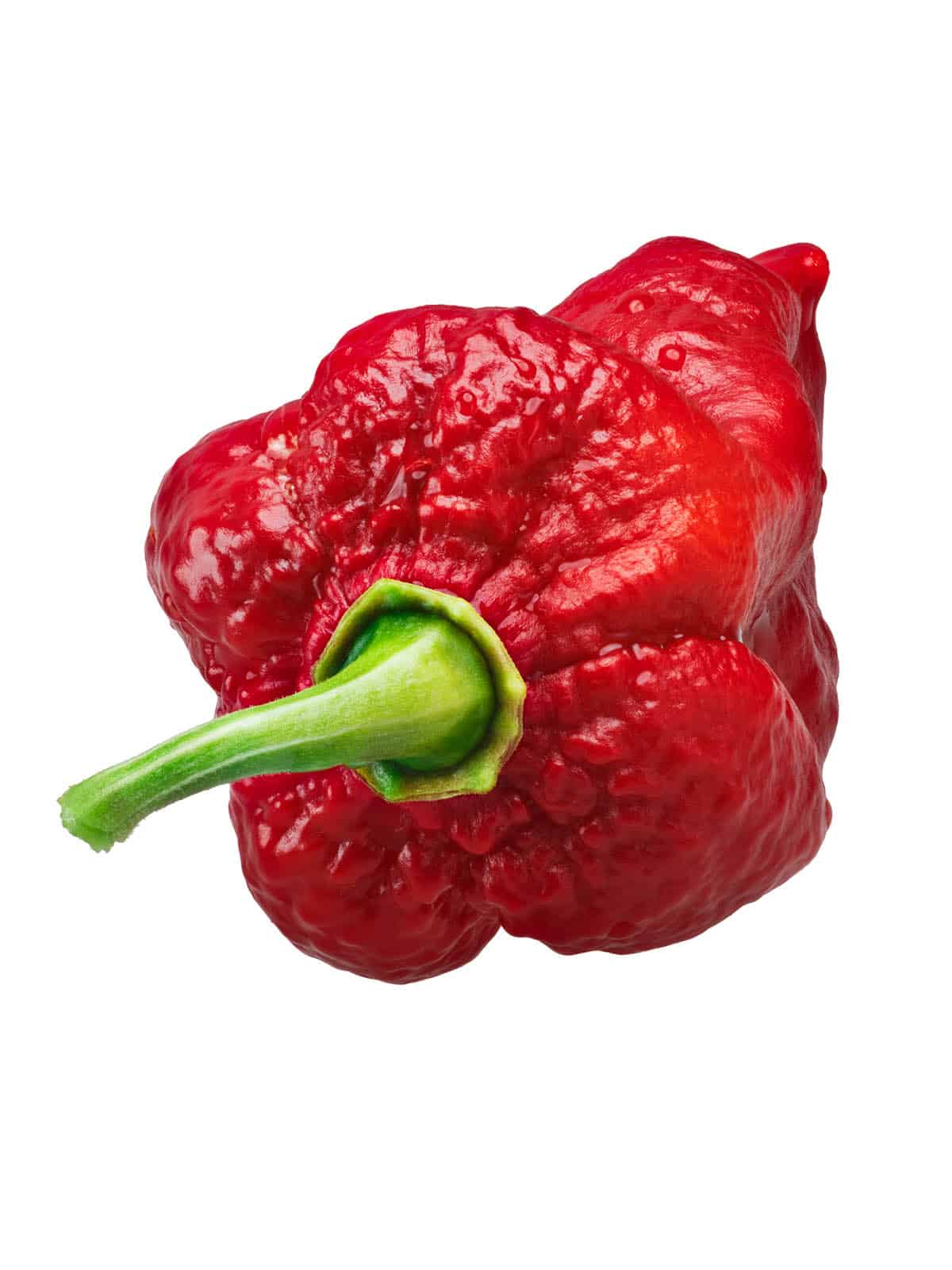
7 Pot Jonah - 1,200,000 Scoville Heat Units (SHU).
The 7 Pot Jonah produces pods that are typically larger than most 7 Pot varieties with bumpy, pocked fruit and scorpion-like tails. They mature to a bright red.
Trinidad 7 Pot - 1,200,000 Scoville Heat Units (SHU).
7 Pot Inifinity - 1,176,182 Scoville Heat Units (SHU).
Bedfordshire Super Naga - 1,120,000 Scoville Heat Units (SHU).
Another superhot produced by UK chili grower, Salvatore Genovese, in Blunham in the county of Bedfordshire, produces 500,000 chilli peppers every week. He also produces the Komodo Dragon chili pepper.
New Mexico Scorpion - 1,191,595 Scoville Heat Units (SHU).
A New Mexico-based team has developed a super-hot chile known as the "New Mexico Scorpion" The New Mexico Scorpion has been rated at 1,191,595 Scoville Heat Units by an independent laboratory.
Spanish Naga (Gibralta Naga) - 1,086,844 Scoville Heat Units (SHU).
The Gibralta Naga, or Spanish Naga, is of course grown in Spain, but was developed in the UK from Indian chili peppers. It beat out the Bhut Jolokia for hottest pepper, but was soon overtaken. As they are grown, they are stressed by creating a hot environment, which helps to make the chiles extremely hot.
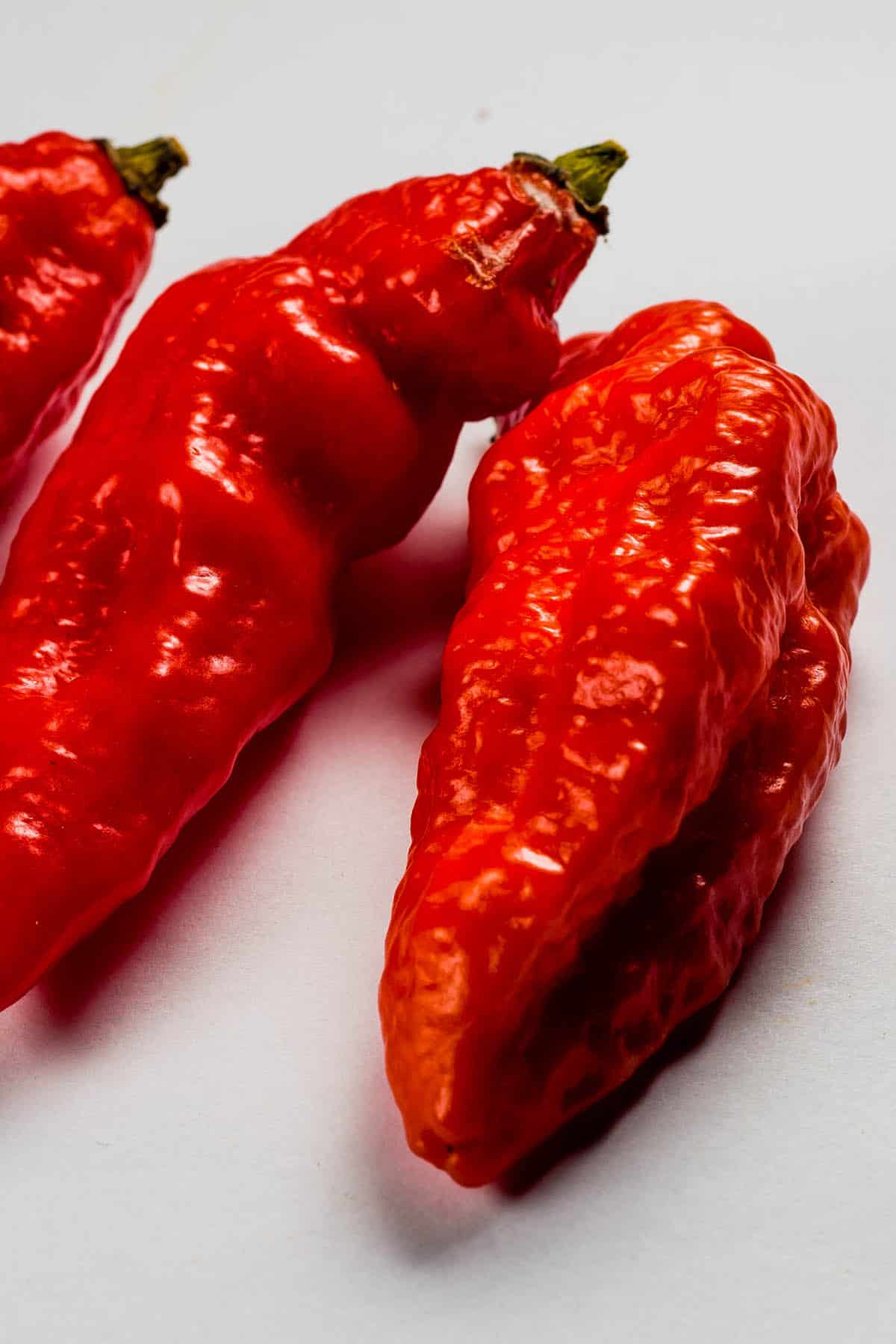
Bhut Jolokia (or Ghost Pepper) - 1,001,304 Scoville Heat Units (SHU).
The ghost pepper (aka bhut jolokia) was officially the hottest peppers around, topping the Red Savina Habanero. It was awarded the distinction of World's Hottest of All Spices by the Guinness World Records in 2006, though was eventually toppled several times over.
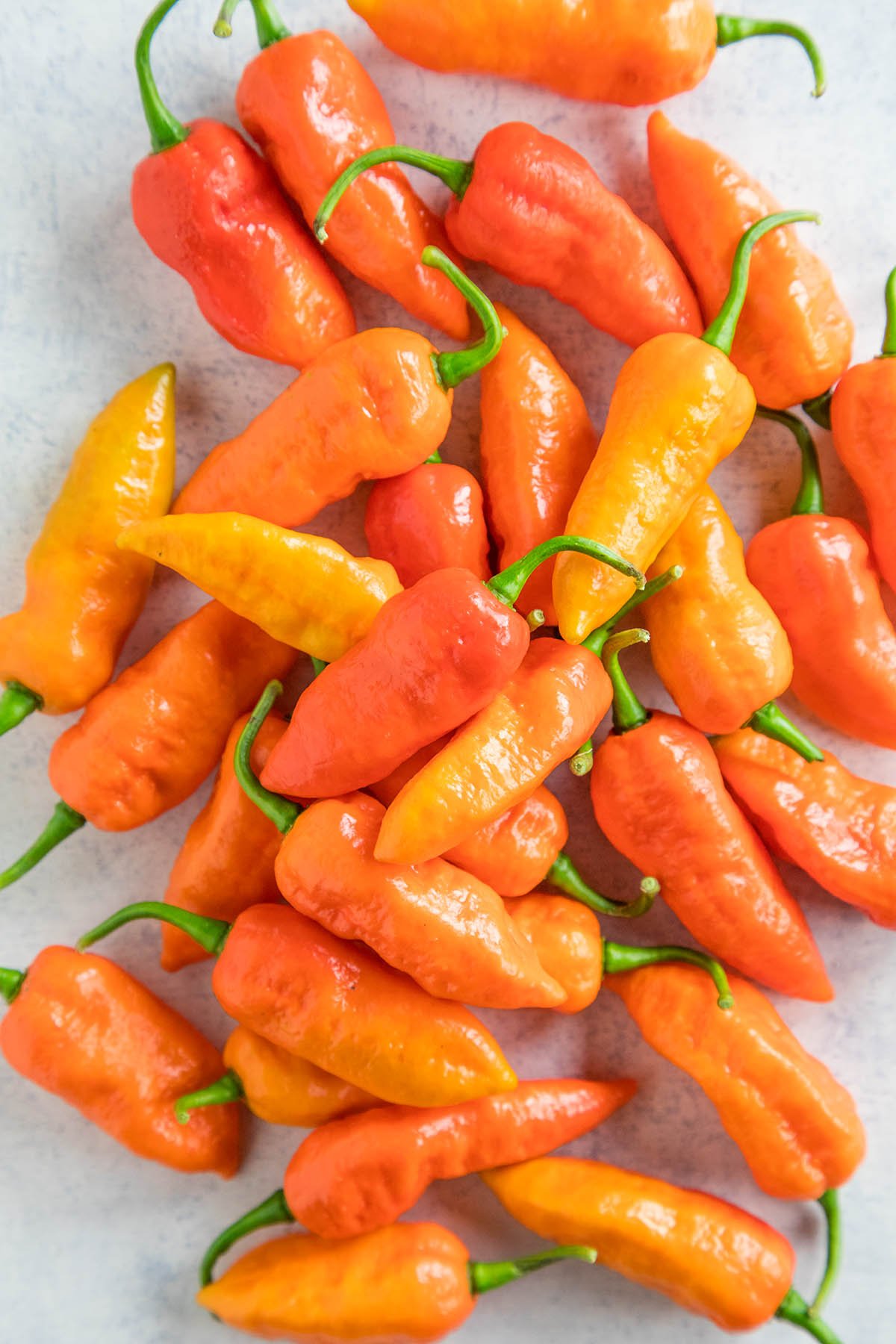
Honorable Mentions
The following peppers may no longer be on the list of the hottest peppers in the world, but once they were and are still considered very hot in their own right.
Trinidad Scorpion CARDI Yellow - 850,000 Scoville Heat Units (SHU)
The Trinidad Scorpion Yellow is from Trinidad. It was given the name "CARDI" as it was developed in part by the Caribbean Agricultural Research and Development Institute. The strain was created in order to standardize the industry for yellow scorpion peppers. The pods start green and mature to a golden yellow, growing to about 4 inches in diameter.
Red Savina Habanero - 200,000 - 580,000 Scoville Heat Units (SHU).
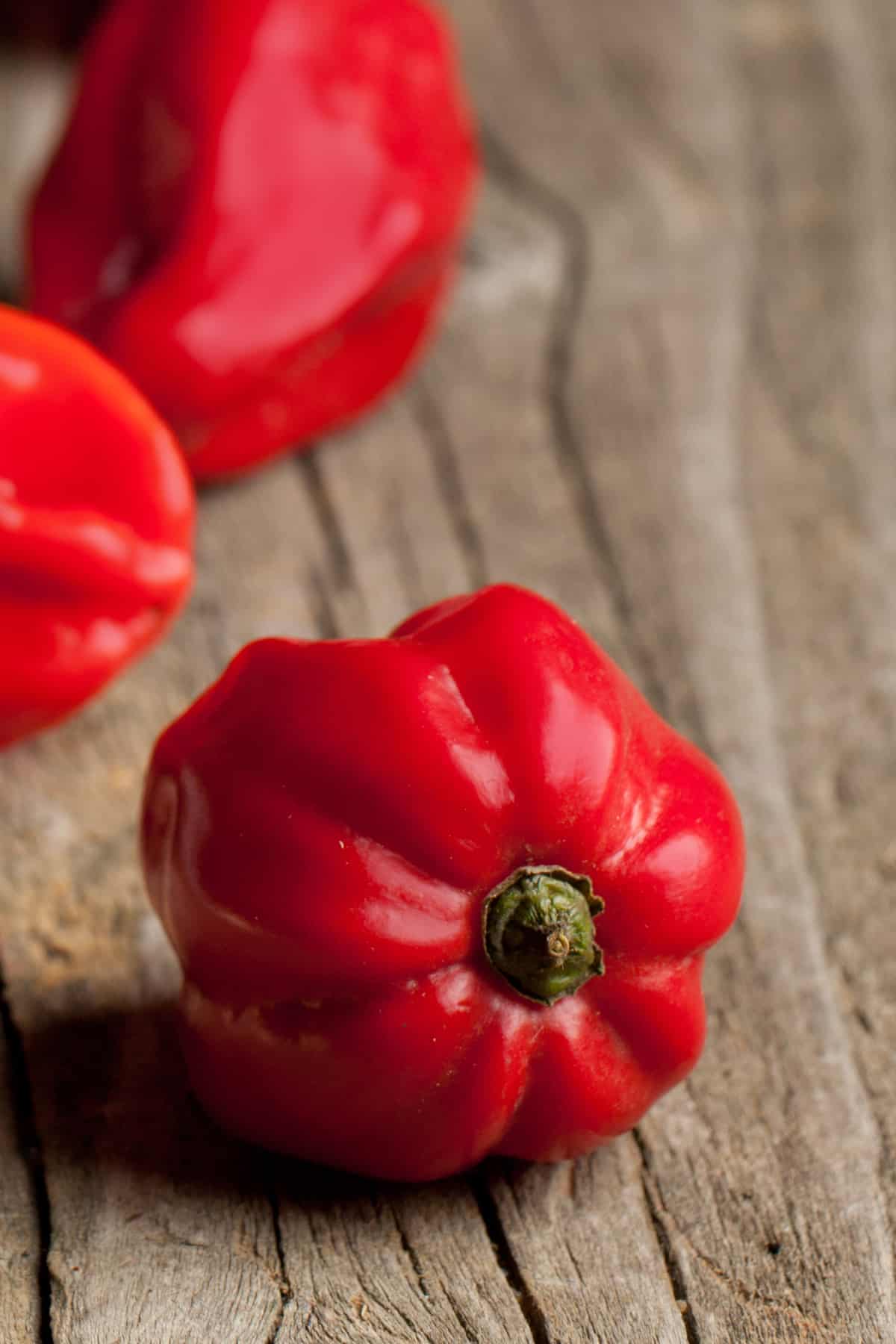
This pepper is a cultivar of the habanero. It once held the Guinness Record for the hottest chili pepper, but the Bhut Jolokia now claims that prize. The red savina is a bright red and robust fruit, with up to 50 fruits appearing per pepper plant.
Got any questions? Or information about new peppers that should be added to the hottest pepper list? Please contact me anytime. I'd love to hear from you. -- Mike Hultquist, Chili Pepper Madness.


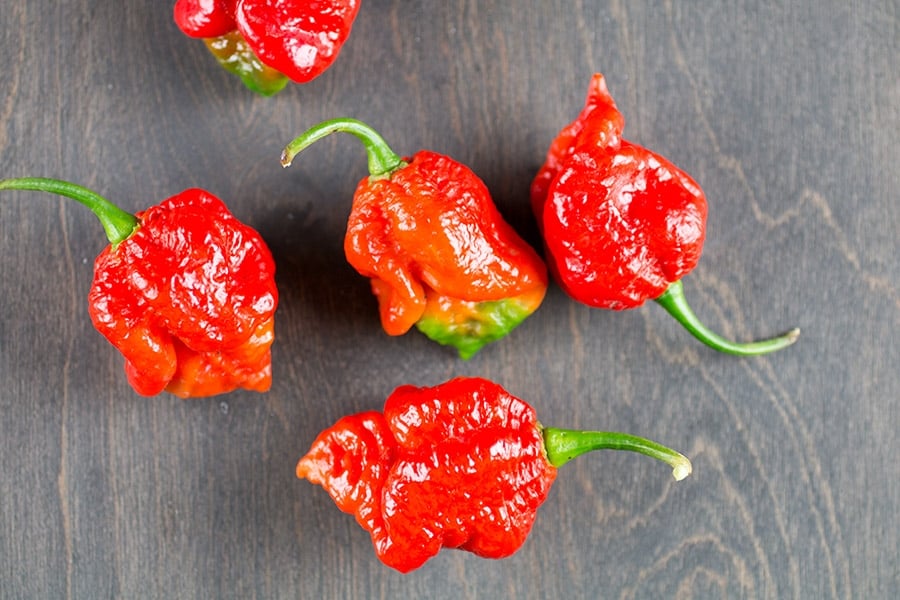
KK St Aug says
I have grown datils for a decade here in St Augustine and I prefer your recipe over locals which tend to sweeten too much for my heat loving taste buds. I am a fan of your site and love your recipes but the picture of a pepper above is a datil pepper not the stated pepper from “Pinterest”! I am happy to provide pics of my peppers at all growth stages, as we are currently in high growth stages. Although, I must admit that I check daily for the ripeness after the purple strip on my sails! I use ALOT of datil sauce!
Mike Hultquist says
Thanks, KK. I appreciate it. I'm growing both peppers this year and need to take new photos. Sauce it up! There is delicious Datil Sauce in my future!
Katie says
Sorry if someone else already asked this, but where do you source your more exotic fresh peppers or, if you grow them yourself, where do you source your seeds? You turned me on to homemade hot sauce and would love to be able to venture outside of habaneros and thai chilis, which are basically the hottest ones I can find locally (gulf coast FL).
Mike Hultquist says
Katie, I grow my own every year, but I do have a list of resources here you can review: https://www.chilipeppermadness.com/resources/. You can also search certain Chili Pepper Growers groups on Facebook, where people share/trade/sell seeds and pods. Good luck!
Deguello says
O.k., but which ones, if any, have a discernible and pleasant flavor underneath the heat?
Mike Hultquist says
That's all personal taste and definitely debatable. I personally enjoy ghosts and 7 pots, though don't eat quite as hot as I used to, so I use them in a blend. They are fruity, though yes, extremely hot. As with anything, it's how you use it. Some people can REALLY tolerate the heat.
Trevor says
If I had to pick one chili pepper I think my favorite is Scotch Bonnet. They look a
lot like some of the crazy peppers on this list. They are hot but not crazy hot and they taste great.
Mike H. says
Great choice, Trevor.
Michael Craven says
I don't get the whole heat thing. What is the attraction for these million plus Scoville unit peppers? Is it some kind of machisimo thing? I like many types of peppers, use them as often as I have opportunity, but heat isn't flavor... imo... habañeros taste like dirt and they're considerably hotter than jalepeños... So what's the appeal for heat?